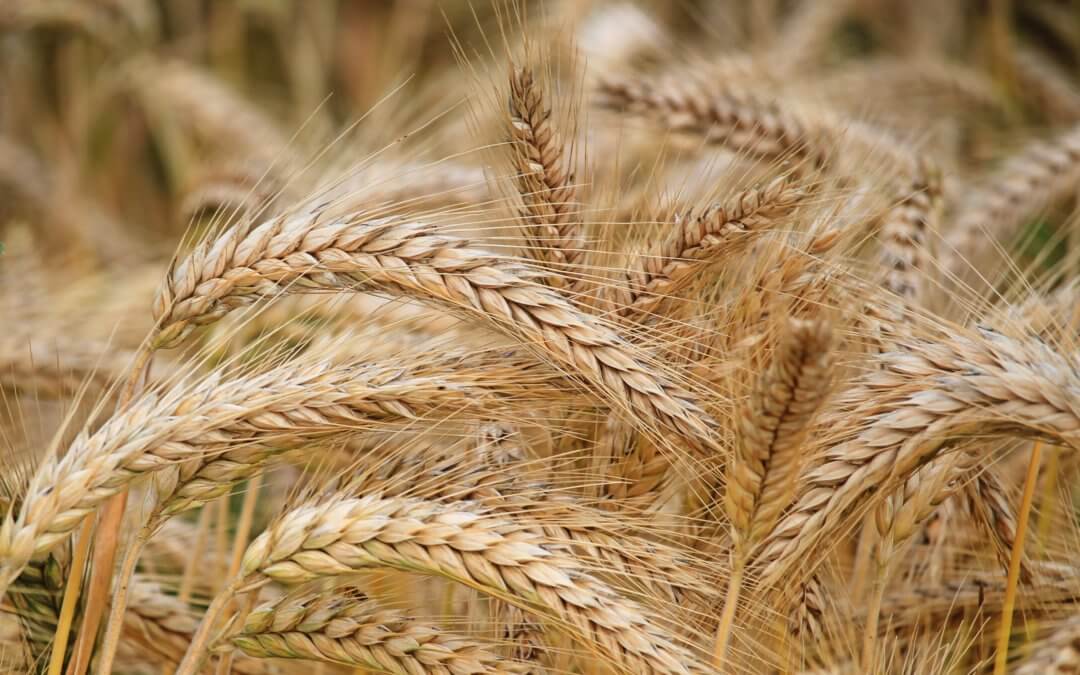It is estimated that 99% of all wheat grown worldwide is either dwarf or semi-dwarf variety. (1) This higher-yield wheat was developed in the 1950s to address concerns with the world’s overpopulation and food shortages.
Since wheat became the global commodity of choice, it has been hybridized (crossbred with other grains and species), and traditional preparation methods have been lost in our industrialization of food.
~ Wheat flour is bleached (unless indicated otherwise).
~ The “whole grain” (germ, bran, and endosperm) is often stripped away, along with valuable nutrients.
~ Fast rise packs of yeast are used instead of a traditional ferment of several hours with a starter culture (aka sourdough bread), but fermentation is what makes grains digestible!
~ Gluten, a naturally occurring protein in wheats, barley, and rye which gives bread its spongy texture, is now often on the ingredient list. Ah yes, the “if some is good, more is better” mentality! Except it isn’t better…
Today’s wheat contains more starch, more gluten, and it alters our intestinal health…all bad news for regulating body fat! (2) This applies to whole wheat products as well.
Let’s look at how each of these hijacks your health in more detail.
1. Starchy Carbohydrates
Grain products contain a particular starch known as amylopectin A. This is rapidly absorbed into the bloodstream, quickly raising blood sugars and consequently, insulin levels. And insulin is a key driver in weight management. (1, 2, 3)
In his book “The Obesity Code – Unlocking the Secrets to Weight Loss”, Dr. Jason Fung, a nephrologist who specializes in treating obesity, writes “wheat is converted to glucose more efficiently than virtually any other starch….Whole wheat and whole grain flours retain some of the bran and germ, but suffer from the same problem of rapid absorption.”
This makes sense, since they all contain amylopectin A. Moreover, any food which is pulverized into fine dust will be quicker to digest and enter the bloodstream, creating blood sugar and insulin spikes. Translation: metabolic mayhem and subsequent weight gain.
2. Gluten Galore!
Gluten is the main protein found in wheat and a few other grains like rye, spelt, kamut and barley. This protein gives bread its sponginess, it’s what makes bread soft and pliable.
Dr. Mark Hyman, MD, founder of The UltraWellness Center, a four-time New York Times bestselling author, and an international leader in the field of Functional Medicine asserts, “ The new dwarf wheat contains twenty-eight, or twice as many chromosomes, and produces a large variety of gluten proteins, including the ones most likely to cause celiac disease.” (4)
On top of dwarf wheat inherently containing more gluten, many commercially made breads and bread products add gluten as an ingredient! So your digestive tract is contending not only with higher gluten content naturally present in the wheat flour itself, but with extra doses the bakeries add into their products!
Think gluten is only an issue for celiacs? Think again! Research has revealed that gluten causes increased intestinal permeability in all individuals, not just those with celiac disease. (2, 5, 6, 7)
Bear with me for one paragraph, while I explain what happens physiologically when you eat wheat…After chowing down that footlong sub – or any wheat product – gliadin, a component of gluten which doesn’t get fully broken down in the body, provokes increased production of zonulin. Zonulin is the substance known to act as a gatekeeper – regulating the opening and closing of the junctions between the cells of the small intestine, which is where food enters into the bloodstream. The more zonulin there is, the more open your intestinal gate.
This means food particles can escape from the digestive tract into the bloodstream before they’re fully broken down, inviting an immune response. (2, 5, 6, 7)
So if you’re regularly eating white or whole wheat products, you may be unknowingly creating chronic inflammation, either overt or lurking below your pain threshold. Although the exact mechanisms are not fully understood, we do know that chronic low-grade inflammation is directly tied to obesity. (8)
Gluten sensitivity has become a recognized clinical diagnosis in recent years; officially known as Non-Celiac Gluten Sensitivity (NCGS). It outnumbers gluten allergy (celiac disease) by six to one, according to current estimates. (9) One study found that adult females are especially susceptible. (10)
Gluten sensitive persons can experience a seemingly endless number of symptoms throughout the body, not just digestive issues. Everything from chronic pain, weight loss or gain, headaches, depression, anxiety, fatigue, hormonal imbalance, and more. (11, 12, 13). In fact, a 2002 study published in The New England Journal of Medicine listed 55 different clinical manifestations associated with gluten reactivity (14).
3. Altered Gut Microbiota
Being gut health focused, this blog got me wondering whether any study has looked specifically at the impact to gut microbiota (the trillions of micro-organisms that live in your digestive tract) from gluten. Sure enough, a human-based, randomized, crossover trial published in 2014 confirmed that gluten consumption alters the microbiome. (15)
This is not surprising when you consider that most gluten we eat comes in the form of bread and packaged foods made from dwarf wheat and too much sugar. Both bread and packaged foods are highly refined. They are quickly broken down in your body and cause a rapid rise in blood sugars. Highly refined, simple carbs are the food choice of a pathogenic microbe present in your intestines, known as candida.
Candida is a term that refers to yeasts, or one-celled fungi, which harmlessly inhabit your microbiome – provided there is a preponderance of beneficial bacteria to keep them in check.
Eating a lot of simple carbs encourages dysbiosis, an overgrowth of pathogenic microbes, like candida, in your gut. Again, bad news for your health, especially if you’re wanting to shed some weight. But that’s another blog post.
There’s so many research findings about common wheat’s negative effects on the body, I was forced to abbreviate this post and stick to a few highlights.
Bottom Line: First, everyone would do well cutting back on refined carbs – which includes any grain-based flours; wheat, gluten-free, or otherwise – in favour of whole foods. Second, wheat is proven to create metabolic dysfunction, mess with intestinal function, and disrupt gut flora. Consider swapping some of your wheat-based dietary staples for alternative grains.
Why not cut back on common wheat (white, whole wheat, in pasta it’s labeled as “durum semolina”) and try other alternatives? There are so many options available to you! Common wheat has some cousins (i.e. spelt, kamut, red fife, and einkorn). There are also a multitude of gluten-free grains and grain-like seeds such as teff, millet, quinoa, brown rice, wheat-free oats, sorghum, amaranth, buckwheat (wheat and gluten-free) to name a few.
Look for sprouted or sourdough versions of those breads, which allows for easier digestion. For those who consider glycemic impact of their meals, sprouted breads have the lowest glycemic response. (16)
Before grabbing the first loaf of sprouted bread you see, be sure to read the ingredient list! Store-bought breads that claim to be sprouted or sourdough will most likely contain a number of other undesirable additions. All you really need in a bread is the flour, some water, and a leavening agent (sourdough or yeast). Local bakers are your best bet.
If you’d like to read further on how wheat is thought to be addictive, it’s impact on the brain, and on LDL cholesterol (the “bad” kind of cholesterol), head over to Healthline’s blog.
Like this post? Please share it – let’s ALL be well!
References
1. Dr J Fung, “The Obesity Code – Unlocking the Secrets of Weight Loss.”, Greystone Books, 2016.
2. Dr J Axe, “Eat Dirt – Why Leaky Gut May be the Root Cause of Your Health Problems and 5 Surprising Steps to Cure It.” Harper Wave, 2016
3. Dr M Hyman, “The Blood Sugar Solution: The Bestselling Programme for Preventing Diabetes, Losing Weight and Feeling Great.” Hodder & Stoughton, May 24, 2012
4. https://www.huffingtonpost.com/dr-mark-hyman/wheat-gluten_b_1274872.html
5. https://www.ncbi.nlm.nih.gov/pubmed/16635908
6. http://www.mdpi.com/2072-6643/7/3/1565/htm
7. https://www.ncbi.nlm.nih.gov/pmc/articles/PMC3384703/
8.https://www.ncbi.nlm.nih.gov/pmc/articles/PMC2952901/
9. https://www.ncbi.nlm.nih.gov/pmc/articles/PMC3292448/?report=classic
10. https://www.ncbi.nlm.nih.gov/pubmed/24885375/
11. drhyman.com/blog/2012/02/22/how-hidden-food-sensitivities-make-you-fat/
12. https://www.ncbi.nlm.nih.gov/pubmed/24885375/
13. https://www.precisionnutrition.com/all-about-gluten
14. Farrell, RJ, and CP Kelly. 2002. Celiac sprue, New England Journal of Medicine 346 (3): 180-88 Review

